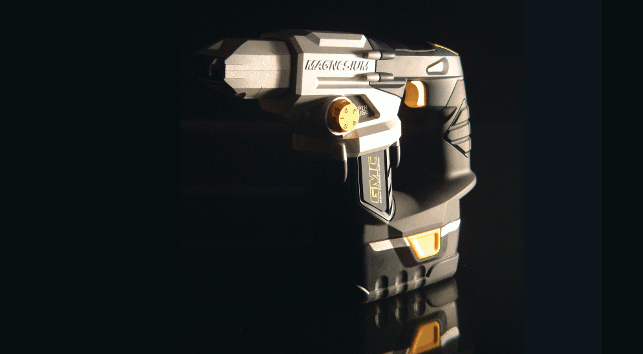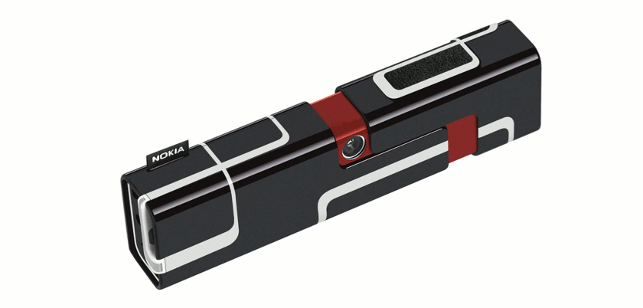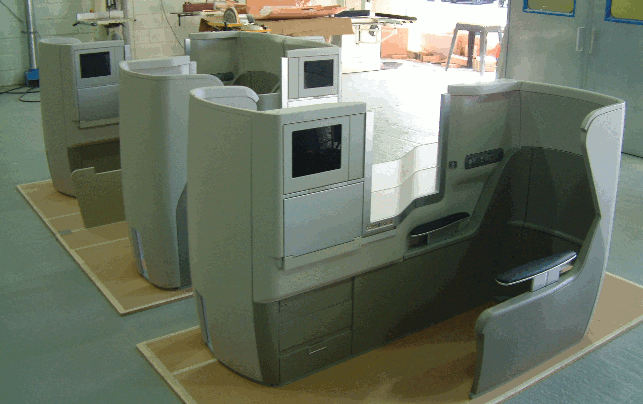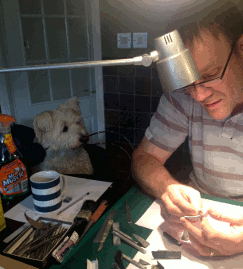Model making is the physical representation of a product to show what it will look like when manufactured.

Full appearance working prototype for Nicholas Rhodes Design
It’s the step in the design process when a drawing or CAD data is translated into three-dimensional reality, whether to the exact size or to scale.
These reference or appearance models can then be assessed with focus groups, put through testing and shown to colleagues and clients.
The model maker, through expertise in specialised manufacturing processes and knowledge of materials, will bring this ‘looks like, feels like’ model to life, accurately representing it in terms of colour, materials, texture and even weight.
To do this they’ll use anything from CNC milling machines and lathes, manually operated machine tools through to disc sanders, circular saws and hand tools, including needle and thread.
In many respects model making is a highly skilled craft with model makers frequently having to work under extreme pressure to achieve the perfect model in the deadline. But the truth is, these skills are no longer required to the extent they once were. Why?
For a variety of reasons it seems. Firstly, clients have forsaken the services of model makers for cheaper and often lower quality models made in emerging economies where labour is plentiful, government sponsorship is abundant and working practices are not as stringent as those in many Western economies.
Secondly, with continued advances in 3D technology, clients are increasingly relying on rapid prototypes or 3D prints to prove a concept. Although these prototypes aren’t necessarily suitable for close-up photography, with the use of rendering software photo-realistic images can easily be created and used in presentations and for marketing materials.
Thirdly, today’s product development lead times are so short that designers don’t have the luxury of the time scales required to produce appearance models. However, these time scales are achievable when using digital technology, which facilitates a theoretical development process from screen to manufacture.
This change of approach by the design industry has led to the demise of a number of highly regarded model making companies.
For example, Chris Hill, managing director of Solve 3D, who at the end of May announced that he was closing his 3,000 square foot workshop in Bedfordshire.
Following 30 years producing high quality models for the design industry, it was a sad day when Hill and his team of skilled craftspeople left the workshop for the last time.
Two months previous another Bedford-based model maker, Mount Design, closed its doors after 43 years.
Others, such as Ogle Models and Malcolm Nicholls, are surviving having diversified their businesses. While still retaining the ability to produce quality reference models, they now offer rapid prototyping and digital services – the areas most in demand by today’s engineers and designers.
Value of model making
So, is there still a place in the design process for traditional reference model making or should it graciously give way to the new kid on the block – 3D printing?
“I think on the 3D printing side there is a lot of excitement and the commercial interest is so powerful that it’s destroying the creativity within what we do,” says Hill. “It feels like it is almost single- handedly trying to eradicate a valuable tool of creativity within the design process and succeeding.”
According to Hill, most designers no longer attach a value to reference models. His argument is that although rapid prototyping has an important role to play in providing a quick and cheap means of evaluating ideas, it’s only one of many tools in the product development toolbox.

Red Dot award winning reference prototypes for Cambridge Industrial Design, 2011
“There is serious monetary value in what we do. For instance, before Nokia became a client of ours, their internal marketing people were slow to agree to design directions. One of the reasons was that the models were not truly representative and always left questions.
When we started making reference models for them – correct weight, crisp detail with production appearance – there were no questions. The marketing teams were able to appreciate the work of their design teams.
“The models were so realistic, that they would be frustrated trying to push the buttons. That was the key – it wasn’t a model anymore – it was a product.”
Skilled craft
Calling a model maker a craftsperson is not lavishing unworthy praise on their abilities. As well as expertise in fabrication techniques and materials, they have a fundamental understanding of form and function.
“We are model makers but we understand design – we understand what it takes to get a product to work.
For example, in the early development of the British Airways Club World seat, the concept was designed but the method of construction, mechanisms, loadings etc. had to be solved for the presentation mock-up. We were provided with basic 3D data, concept sketches colour materials and finishes and we did the rest,” explains Hill.

Nokia Reference model, 2003
Model makers also have to possess a significant understanding of engineering principles because they are often required to create a mechanical solution to demonstrate a concept. “One of the models we made for Nokia required a special hinge, which at that early concept stage we had to design and make ourselves. After we had submitted it, I received a call from one of Nokia’s engineers asking how we achieved it.”
Hill admits, being a perfectionist is more of a curse than an asset. Over the years he has worked on a vast range of projects from consumer electronics and luxury goods to transport interiors and bespoke furniture either directly for a manufacturer such as Samsung, Nokia and Herman Miller or design consultancies including Tangerine, The Division and Seymour Powell.
Whoever the client, he has always enjoyed working directly with the designers and believes these collaborations have a dynamism that fosters intense creativity from both directions. “An intuitive rapport between designer and maker was often the result.
They would ask my opinion and value it. Even if they didn’t always agree, which was sometimes the case, there was always mutual respect.
“In the last few years this has changed. We’ve increasingly found ourselves working through marketing people or buyers who ‘demand’ without understanding the process and what is involved, above all, the implications of time and budgetary limitations. There is simply no discussion,” comments Hill.
Lost skill set
It seems clear, that in a few years model making in its traditional form will completely disappear especially as product model making courses are no longer offered by UK universities.
The lack of perceived commercial value alone makes it unviable. “Guys like us won’t be around for much longer, model making will be an entirely lost skill set. Does the industry really want to see these skills disappear?”
But this is the reality with Hill and others like him having to shut up shop. It is a business he can no longer sustain not least of all because the supply chain is unreliable and patchy, material prices have increased every year and clients continually drive down price.
“Take our stats over a 15 year period – we’ve had a 37 per cent increase in costs and, depending on the client, between a 15 and 30 per cent reduction in what we are able to charge,” explains Hill.
“For example, 15 years ago we were charging about £3,000 for a mobile phone model and now, in some cases, we are expected to build it for £900 despite our 37 per cent increase in costs. That’s a very compelling reason why we can’t keep a fully equipped and staffed workshop.
The new generation of designers do not place a value distinction between our core skill of reference model making and a 3D printed model, they certainly don’t want to pay the difference.”
Moving with the times
It is hard for Hill not to feel bitter and he has resigned to the fact that there is no commercial basis to continue doing what he loves and has a passion for.
“One of the hardest pills to swallow was to lose my team. I miss their collective, creative genius,” he comments.
After a break following the closure of his workshop, which gave him time to reflect, Hill now runs Solve 3D from his small studio at home and has invested in a 3D printer.

‘BA Club World’ working mock-up’s for Tangerine and BA, 2006
Having benchmarked a number of the additive processes he chose an Objet30 Pro machine, which has been used to capacity on several projects since its installation at the end of August.
“The 30 Pro is a nice tool and the guys at [UK supplier] SYS have been incredibly supportive. I have to think and work in a different way and I miss my CNC kit and spray booth but I am getting the 30 Pro to sing,” smiles Hill, albeit with a tinge of sadness.
Although this isn’t the path Hill necessarily wanted to take, it is already delivering a number of positives.
A long term consultancy contract, a steady flow of work keeping the 3D printer busy but perhaps, most importantly, the time to develop his own product ideas, a luxury he did not have in the day-to-day heat of a workshop, and possibly the spark that keeps the passion for product development burning.
Are we losing a skill set?
Default







